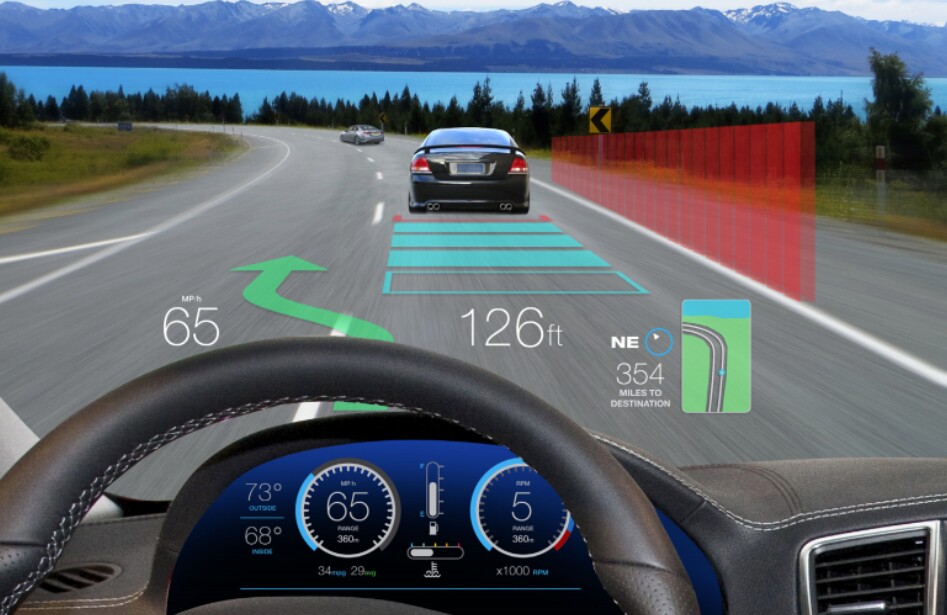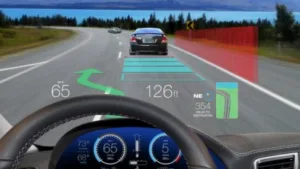Making a simple automotive head-up display (HUD) is easy, and basic aftermarket units are available for less than $50. These are the units that pick up basic instrumentation info from the vehicle’s OBD II port and/or turn-by-turn navigation data from the operator’s cellphone.

One version holds your cellphone on the dash where the screen is reflected from a combiner. It’s hard to imagine the data is visible against a snow-covered hill bright with sun, but the device should work well enough for those who drive by night.
Things get much more difficult when you try to design a HUD suitable for augmented reality (AR) because, here, the projector must create an image that covers much of the driver’s field of view (FOV) through the windshield – up to 17 x 6.5 degrees — rather than the 3 x 1 degrees of a basic aftermarket HUD, and the image must appear to be at a distance of seven to 20 meters rather than a meter or so.
The problem with making such a wide-FOV AR-HUD with today’s existing projector-and-mirror technology is that it occupies a volume on the order of 30 liters. Those of us who live in the non-metric world might remember that “a liter is a quart plus a martini.” Most current vehicles don’t have room for 30 martinis behind their crowded instrument panels much less 30 liters. So it’s no surprise that the serious players are trying to develop projection technologies that will produce wide FOV on the windshield while occupying much less volume behind the dash.
When I last spoke to Tier One supplier, Visteon, they were focusing on combiner-type HUDs for OEM installation. Although they are developing and showing windshield FOVs with fairly large FOVs, they are very level-headed about the volume issue and are not projecting significant sales for the foreseeable future.
TI is promoting projection systems based on its venerable DMD micromirror device, promoting it as a volume-saver, and is selling chipsets to Tier One suppliers. Continental has a DMD HUD system with a modest FOV of 10 by 3.5 degrees. The spec sheet does not specify the volume.
 An effective AR HUD must have a large enough field of view so that imagery can be painted over a large enough area of road to be useful. The complexities of creating the AR imagery in real time, positioning it precisely on the road surface, and making sure it is stable and artifact-free are another story. So be warned. An “AR ready” HUD is not the same as an “AR HUD.” (Image source: Unknown)
An effective AR HUD must have a large enough field of view so that imagery can be painted over a large enough area of road to be useful. The complexities of creating the AR imagery in real time, positioning it precisely on the road surface, and making sure it is stable and artifact-free are another story. So be warned. An “AR ready” HUD is not the same as an “AR HUD.” (Image source: Unknown)
What really excites Continental, though, is the waveguide technology developed by its (now subsidiary) DigiLens. Instead of a mirror, with it’s volume-consuming optical path, the Digi-Lens approach uses a stack of waveguides, one each for R, G, and B. There is still a projector, but its distance from the waveguides is flexible. Each of the three waveguides has an input grating, the waveguide portion, and an output grating. The colors from the three gratings mix as they leave their gratings and are directed to the windshield at the proper angle.
Says Continental’s Dr. Pablo Richter: “The light rays from the projector enter the multi-layer waveguide from underneath. They get folded inside the waveguide and are finally projected upwards to create the virtual image through reflection on the windscree.” Continental seems delighted that they now have a full-color demonstrator. The demonstrator “enables augmentations within a field of 2.60 meters x 0.87 meters at a projection distance of 10 meters.”
Continental is a major Tier One, and they may well have the technology that will be the first to break the martini barrier. If you know of any others, please comment. – Ken Werner
Ken Werner is Principal of Nutmeg Consultants, specializing in the display industry, manufacturing, technology, and applications, including mobile devices, automotive, and television. He consults for attorneys, investment analysts, and companies re-positioning themselves within the display industry or using displays in their products. He is the 2017 recipient of the Society for Information Display’s Lewis and Beatrice Winner Award. You can reach him at [email protected].

